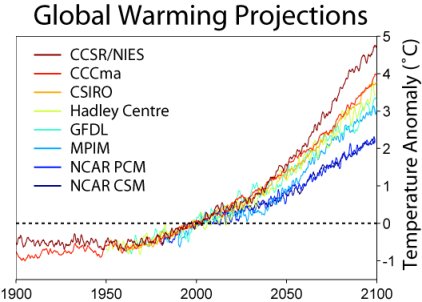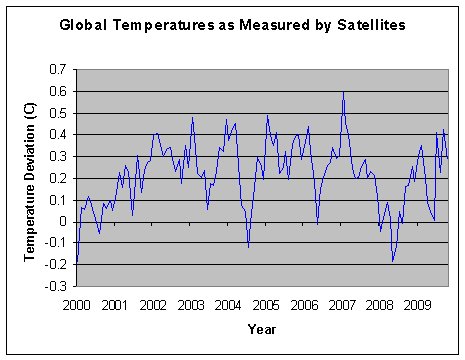Global climate models (GCMs) are one of the driving forces behind the idea that global warming is real and is the result of human activity. These models attempt to simulate global climate as a result of various input parameters, one of which is the amount of carbon dioxide in the atmosphere. These global climate models generally agree that the earth should be warming due to the increased levels of carbon dioxide found in the atmosphere. For example, here are the projections made by several different GCMs back in 2000:

Note that global temperatures were predicted to rise throughout the decade of 2000-2010. Instead, global temperatures have remained remarkably steady over that same time period:

So why have the computer model projections fared so poorly when compared to what has actually happened so far? Well, it seems that one of the real luminaries of climate science, Richard Lindzen, has found at least part of the answer to that question1.
In their study, Lindzen and his colleague (Yong-Sang Choi) used the Earth Radiation Budget Experiment (ERBE) to see how the heat emitted by the earth changed with changing sea surface temperatures (SSTs) over a 16-year period. The general assumption of the climatology community has been that rising SSTs would result in increased water vapor in the air, which would result in further increases in temperature. This is called a positive feedback mechanism – increasing temperatures cause temperatures to increase even more.
However, what Lindzen’s study shows is the exact opposite. As sea surface temperatures rise, there is apparently a negative feedback mechanism at work. As he and his co-author state:
The observed behavior of radiation fluxes implies negative feedback processes associated with relatively low climate sensitivity.
In other words, while climate models predict that increased SSTs will result in further increases in global warming, observations show just the opposite. Indeed, they say:
This is the opposite of the behavior of 11 atmospheric models forced by the same SSTs. Therefore, the models display much higher climate sensitivity than is inferred from ERBE…
So the Global Climate Models, which are what most of global warming hysteria is based on, don’t even model the sensitivity of global climate to sea surface temperatures correctly. In fact, they model it opposite of the way it really works. Since seas cover the majority of the earth, you would think that the GCMs should get SST sensitivity right before we start making huge decisions based on their predictions!
One thing to note about this study is that it focused on the tropics. While it is reasonable to assume that the climate changes resulting from SST changes are probably based on the same basic physics in all parts of the earth, we cannot be sure. Thus, more work has to be done so that we truly understand this wonderful negative feedback system that occurs as a result of sea surface temperatures.
Now I must point out that while Lindzen and Choi have given us even more reason to doubt the hysterical predictions of the IPCC, there is something else they have done. They have provided more evidence for the amazing ingenuity of our Creator. Negative feedback mechanisms are the hallmark of careful design. After all, if a system’s job is to stay in a particular state, then every time there is a change, the system must respond in the opposite direction of that change. We see this in all well-designed systems, including the earth.
REFERENCE
1. Richard S. Lindzen and Yong-Sang Choi, On the determination of climate feedbacks from ERBE data, Geophysical Research Letters 36, L16705,2009 | doi: 10.1029/2009GL039628. Available online
Return to Text
